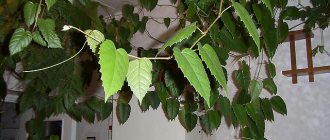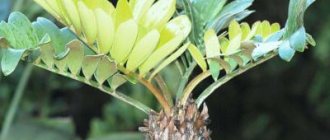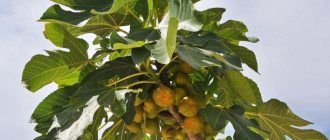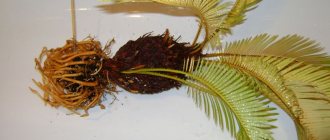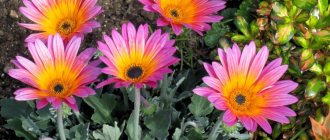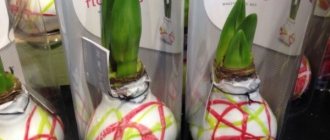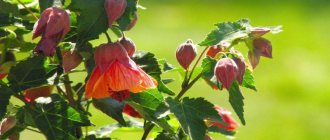Features of the plant
Cissus is a genus of plants belonging to the Vine family (Vitaceae). The natural habitat of the flower is Africa, Asia, Australia and South America. Cissus grows in tropical or subtropical climates, but now it can be found almost all over the world, because... it grows well indoors. The name of the plant is translated from Greek as “ivy.”
Cissus can be grown as a vine or as a bush. To grow a plant in a pot, you need to put a support in it; when the bush reaches the height of the support, it should be trimmed. After this, the cissus begins to bush.
More often at home, cissus is grown in hanging pots. The liana has tendrils like grapes, they cling to supports to fix themselves.
Cissus grows quite quickly: in 2-3 years the vine reaches a length of 3 m. In addition, it should be borne in mind that if the bush grows in comfortable conditions, its growth accelerates significantly.
Cissus is an evergreen vine. It has a fairly compact rhizome. Flexible shoots can reach a length of 3-3.5 m. Over time, the shoots become woody and covered with gray bark, which cracks and peels off over the years. The stem contains internodes with petiolate leaves and tendrils. Leaf blades can be entire, palmate or lobed. The leaves are glossy, bright green.
Cissus hardly blooms indoors; in nature it blooms in summer. The inflorescences are umbrella-shaped with inconspicuous white flowers. The crown itself is of great value.
The plant feels good in the conditions of central Russia. As it grows, it can cover large areas.
Possible problems
If you systematically inspect the cissus and care for it properly, then you will be able to avoid many problems that may arise when growing it indoors.
- If the leaves of the plant bend and begin to dry , then the air in the room is very dry. Initially, you need to moisten the space around the vine and spray the leaves with water.
- The leaves dry out and fly off due to the high temperature in the room. It is necessary to move the flower to a cool room, and in the summer it can be taken out into the air.
- If the leaves turn pale or have light spots on them, this indicates that the light is too bright and the leaves are sunburned. The plant should be shaded.
- Cissus has brown spots due to severe waterlogging of the soil. It is necessary to stop watering so that the top layer of soil dries out by 2-3 cm.
- If Cissus is actively shedding leaves , it must be moved out of a cold room and protected from drafts. And also create the desired temperature regime for Cissus.
- The leaves wither and fade , the plant slows down. Cissus lacks nutrients. The appearance of black spots indicates a lack of phosphorus, brown spots indicate a lack of nitrogen. It is necessary to select a fertilizer with a balanced composition and feed the vine in a timely manner.
- Cissus stops growing , young branches do not appear. The plant has taken up the entire space of the pot; it needs to be transplanted into a larger pot.
Popular types
The genus includes almost 300 plant species. However, only a small part is suitable for growing at home, in particular: Antarctic, diamond-leaved and multi-colored cissus.
Antarctic cissus (Cissus antarctica)
The plant is popularly called the “Kangaroo liana.” The leaf blade has an oval shape, its length is 5-8 cm. The leaves are dark green, the inside is lighter. There are dark brown hairs on the surface of the branches and shoots. The flowers are collected in inflorescences and painted in a light green shade. The standard length of the vine is 2-2.5 m.
The Antarctic species loves partial shade or shade, needs frequent watering and high humidity.
Cissus rhombifolia
The name is given in honor of the shape of the leaf plate, it resembles a rhombus. Among gardeners, the vine is nicknamed “grape ivy.”
The fast-growing vine grows 1.5-2 m per year. It tolerates the climate of enclosed spaces well. Practically does not respond to rearrangement or slight changes in temperature. Cissus rhombifolia is able to grow even where other vegetation does not take root.
The most popular varieties: “Mandiana” (the plant has large leaves), “Ellen Danika” (a decorative vine with a rich color).
Cissus discolor
It is distinguished by an extremely unusual color: the lower part of the leaves is full of red-pink flowers, and the upper part is decorated with a silver-white pattern. One of the varieties of this species, “Amazon,” has branches painted pink.
The leaf blade has the shape of a slightly oblong heart, it reaches 10 cm in length and 5-8 cm in width. Multi-colored cissus does not like climate change and cold air. Even during the dormant period, the plant must be left in place, maintaining the same climatic conditions. It is distinguished by particularly delicate and fragile roots.
A plant of this species sheds its leaves when the heating starts working. It does not tolerate dry air, so it is recommended to place containers with wet peat next to multi-colored cissus. Evaporation will create moisture around the flower. The plant should be sprayed throughout the year.
Quadrangular cissus (Cissus quadrangularis)
Unlike other species, this one grows quite slowly. The plant reaches 1.5 m in length. The shoots are quadrangular, with internodes, 8-10 cm long and 1.2-1.5 cm wide. Small thickenings form on the stems, which give the plant an unusual appearance. The foliage has thin tendrils, thanks to which the plant is attached to the supports. The older the plant, the more woody the base of the stem becomes. Small inflorescences are colored yellow or white.
Cissus cactiformis
This species has reduced foliage. Instead, stems are formed, which over time become fleshy and begin to resemble a cactus. This feature is explained by the fact that the plant adapted to dry areas. Tendrils grow in the internodes; they help to attach to supports.
Cissus Jutta, Cyphostemma Jutta (Cissus juttae)
This cissus is extremely different from other species. A plant with a fleshy straight stem can grow 1.5-2.5 m. The leaf blade is large, oval in shape, with teeth along the edge. Foliage shades range from light green to olive. The surface of the plate has a layer of wax that protects the leaves from damage. The trunk is quite large; with age, it begins to delaminate into thin plates and forms thickenings of unusual shape.
Cissus bainesii
A perennial plant in the form of a shrub. The trunk can expand at the base up to 20 cm and have several branches. The maximum height of the variety is 40-50 cm. The foliage is located in the upper part of the shoots, on short petioles; the leaves contain trifoliate lobes. The crown is painted in a bright yellow-green color. The shape of the plate is oval, with teeth along the edge, the dimensions of the plate are small (up to 12 cm). There is pubescence on the surface, so the leaves feel like felt to the touch.
Cissus Bottle, Cissus Tuberose, Cissus caudex (Cissus tuberosus)
The leaves have an unusual shape and openwork cutouts, thanks to which they vaguely resemble snowflakes. Closer to the top, the vine forms shoots with aerial roots; they are light, flexible and thin. The base of the trunk is thickened, green at first, but over time it can become covered with thin silvery bark.
Round-leaved cissus, cissus rotundifolia (Cissus rotundifolia)
It is distinguished by round plates with a diameter of 8 cm. The texture of the leaves is glossy, leathery, the edges are jagged. The foliage is light green, sometimes with a blue tint visible. The stem is woody, the bark is gray-brown. This species is rarely seen on store shelves.
Glandular cissus (Cissus adenopoda)
The species is interesting due to its unusual structure and color. The trifoliate structure of the leaf sets it apart from the bulk of other species, and the crimson color of the inner surface of the plates attracts attention. The outer side has a rich green color. There are teeth along the edge. Pink fluff is visible on the surface of the crown and shoots. The glandular species also has antennae that easily cling to supports.
Cissus striata, striped cissus (Cissus striata)
Cissus striata is a climbing perennial plant. Young stems are purple in color. The plant is capable of growing 10 m. The leaf blade is ovoid in shape, colored in a bright, almost poisonous, green color, similar in appearance to girlish grapes. The surface of the leaves is glossy, with teeth running along the edges.
Types of cissus with photos and names
There are approximately 300 species of cissus in total, but only a few of them are cultivated by gardeners indoors. Moreover, each of these species has several varieties that differ from each other. They have very high unpretentiousness and endurance.
Cissus rhombifolia
This species was named so because its foliage is diamond-shaped. It belongs to fast-growing plants. If you take good care of it, then during just one growing season it can gain up to 200 cm in length. This vine is highly resilient, and it also grows well in places with unfavorable conditions.
Cissus discolor
This species is valuable because it has variegated, showy foliage, with the main color being pale red. There are specks of silver color on the entire surface of the plate, while its reverse surface is purple.
Cissus striata, or striped
The foliage has a shape very similar to girlish grapes. Varieties with a pale red color are grown as decorative vines. It is distinguished by its endurance, unpretentiousness and rapid growth.
Antarctic cissus (cissus antarctica)
This highly decorative species is more demanding in care. When there is poor lighting, the growth of the bush slows down, and it may also suffer due to excessively low air humidity. The foliage color is green, monochromatic.
The most decorative of all cissus grown at home is the variegated cissus. It stands out among other species with its spectacular and unusual color. However, you need to be prepared for the fact that growing it is not so easy. In nature, such a plant is found in the tropics. Therefore, in order for the vine to grow and develop quickly, the air temperature in the room must always be at least 25 degrees, and it also needs high humidity. Local residents of the island of Java cut the shoots of the vine and drink its juice.
Caring for Cissus. CISSUS. UNpretentious indoor creepers
Cissus care
Cissus is unpretentious, but requires regular watering and fertilization. Without these two components, the plant loses its foliage, stops growing, or becomes lethargic.
Temperature
Prefers a constant climate with a temperature of 19-25°C. During the rest period, the temperature can be reduced to 18°C. Multi-colored cissus needs the same temperature throughout the year.
The critical temperature threshold is 10°C. If the temperature is lower, the plant will die. In the room where the flower stands there should be no drafts or intense heating devices, as this provokes loss of foliage.
Illumination
The plant is unpretentious to the level of lighting. Can grow well even in partial shade and shade. However, placing it on southern windows will be detrimental, since cissus does not like bright sunlight. The best option is diffused bright light.
Different varieties of cissus have their own lighting requirements. Rhomboid cissus prefers brighter light, while Antarctic cissus, on the contrary, loves partial shade.
Humidity
The plant needs high humidity. Caring for cissus should include regular spraying (once a day in summer, and twice a day in winter); it is also recommended to install a humidifier or place containers with water or wet peat around the radius.
Large and mature species should be wiped with a damp sponge to remove a layer of dust from the leaves.
Watering
Watering is required frequently, but moderately. The soil must not become acidic or stagnate, as this will cause damage to the root system. Cissus should be watered immediately after the top layer of soil has dried. In spring and summer, the plant responds well to spraying.
During the dormant period, watering should be reduced by 1.5-2 times. However, if the air in the room is dry, then it is recommended to leave the irrigation regime the same throughout the year.
It is recommended to choose a pot with a tray so that all excess water can flow out freely. After watering, the tray should be emptied.
Top dressing
Cissus needs a large dose of feeding. They must be paid every week. Fertilizer input should begin in mid-February and stop by early September. If the plant does not have a dormant period in winter, it will also need feeding, but once every 2 weeks.
The fertilizer must contain nitrogen. It is he who helps build the green part of the plant, of which the cissus is almost entirely composed. Liana reacts positively to any complex mineral supplements for decorative foliage plants.
Transfer
You can start replanting in early to mid-spring. Until the flower is 5 years old, replanting must be done every year, after which once every 2-3 years will be sufficient.
Cissus should not be replanted more than once a year. The liana is sensitive to transplantation, and weak roots break easily.
Cissus has a positive attitude towards strong immersion under the ground. It can be buried up to the first internode. Installation of support is required.
After transplantation, the plant must be placed in a shaded room where it will take root.
Trimming and pinching
The plant needs formative pruning when grown as a bush. If the cissus grows like a vine, then you need to trim the shoots that turn in the wrong direction. It is also recommended to remove branches that are too elongated, darkened or damaged.
To increase branching, you can pinch young branches in the spring. The procedure stimulates active growth and branching of new shoots.
It is best to prune cissus in the spring, during the active growing season. Then the recovery process will take less time.
Rest period
For cissus, the time of hibernation begins in the winter months, but in this plant this period is not as pronounced as in others. Cissus only temporarily slows down its growth.
At this time, feeding is stopped or reduced to once every 2 weeks. The air temperature should be reduced to 16-18 °C. It is permissible to continue care in the same mode as in the summer.
In winter, there is a risk of overflowing, because moisture evaporates at a slower rate. After watering, be sure to remove the water that has flowed into the pan.
Diseases and pests
The main difficulties encountered when growing cissus and their possible causes:
- Mold on leaves means poor drainage. It is necessary to remove all affected leaves, treat the plant with fungicides and replant it in a new pot.
- The tips of the cissus leaves dry out - dry air. Need to spray more often.
- Cissus grows slowly - lack of light and nutrients. Feeding with liquid fertilizer is necessary.
- Pale leaves of cissus indicate “starvation” (the plant needs to be fed) or too much light.
- Cissus leaves fall off - low room temperature. If leaves wilt and fall off, it may be caused by strong sunlight or lack of moisture.
- Brown “papery” spots on the leaves indicate dry air. If spots appear on the lower leaves, this indicates a lack of moisture. Also, spots and rot can appear from waterlogging of the soil.
- Cissus leaves curl - a signal that the plant lacks moisture.
- The leaves are bending - there is dry air in the room, you need to increase spraying.
- Loss of color in the leaves is a lack of nutrients, you need to apply fertilizer.
- Wrinkling of the lower leaves means insufficient watering.
- Exposure of the lower part of the plant stem can be caused by a lack or, conversely, an excess of light.
Among the pests, cissus plants in indoor culture are affected by spider mites, aphids, and scale insects.
How to plant cissus?
Planting cissus is not difficult. If you choose the right pot and soil, there will be no problems.
Pot
It is better to immediately plant the cuttings in separate containers, covering them with a glass jar. This way they will quickly take root.
Cissus is a vine that is grown as an hanging plant, so hanging pots are often chosen for it. The material can be any, ceramics being the priority.
For adult plants, the pot needs to be selected a little larger than the previous one so that the root system can develop further. There should be a distance of 1.5 cm between the earthen lump and the walls of the pot. The height and diameter of the pot should be approximately equal to each other.
Soil and drainage
Cissus requires soil with neutral or low acidity. It may include leaf soil, turf soil, peat, humus and sand. All ingredients must be mixed in equal proportions. In addition, the plant grows well in a universal substrate, as well as in a special soil for vines.
At the bottom of the pot it is necessary to make a drainage layer, for example, from expanded clay.
Place
The correct choice of location depends on the type of cissus. For example, the Antarctic species prefers shade. The main condition for any plant is to avoid the burning rays of the sun and observe the daylight hours. Also, you should not place the vine near heating appliances or on windows where there is a draft in winter.
The best location is on a southwest window or in the back of a well-lit room.
Step-by-step instructions for planting cissus
- Prepare the pot, drainage and soil.
- Before the procedure, water the plant in an old pot generously.
- Place a drainage layer on the bottom of the new container and lightly sprinkle it with soil.
- Remove the plant along with the earthen lump, carefully freeing the roots. You can leave the whole lump, because... The roots of cissus are tender and may be damaged.
- Place the vine in the center of the pot, and then fill the resulting voids with soil.
- Water the plant again and leave it for 5-7 days in a shaded area, giving it time to recover.
You can introduce fertilizing, prune, and put the vine in its original place in 10-14 days.
General description of the plant
"Cissus" is an unpretentious houseplant. Valued for its innocence. The flower is widespread in Russia, Ukraine, and Belarus.
It is grown by hanging. Great for growing in hanging plant pots or deep pots. It is an excellent decor for a green corner.
In the wild it can grow in the tropical forests of South Africa. Homeland - South Africa. Most subspecies of this wonderful plant are climbing evergreen vines.
Thanks to the tendrils, the grapes cling to handrails and supports. The leaves of this flower are wide, whole, dissected in the middle. Flowering, even with good care, is very rare. The flowers are inconspicuous, miniature. They are bunched together into small false umbrellas.
The plant is valued for its abundant delicate flowering. Experienced flower growers very often call the flower indoor birch and home grapes (you can find out more about the “birch” as a home plant here).
Reference! Latin name: "Cissus". It belongs to the family "Vitaceae".
This flower family includes about three hundred species of different flowers and plants. The most popular types of "Cissus": Antarctic, Variegated and Rhomboid.
Reproduction of cissus
The liana is propagated in several ways: by cuttings, dividing the bush, layering and seeds. The most convenient and fastest way is cuttings.
Cuttings
Young shoots can be prepared at any time of the year. You need to choose shoots with 2-3 leaves. The incision should be made under the kidney. Tools must be sharp and disinfected.
Tips for propagation by cuttings:
- The shoots should be immediately planted in separate small-diameter pots.
- During adaptation, it is recommended to place them in a room with a temperature of 20-22°C and water them abundantly. The substrate should be light, with a good proportion of sand and peat.
- The appearance of new shoots and leaves is a signal of successful rooting. This usually happens within 2-3 weeks.
Dividing the bush
When the bush branches well and has already gained mass, it can be divided into 2 parts:
- The plant should be well watered beforehand. It is better to start the procedure early in the morning in the spring-summer season.
- For separated parts, it is necessary to slightly shorten the shoots, then the survival rate will accelerate.
- Both parts need to be planted in new containers.
Layerings
- For layering, you need to prepare a separate pot with the same substrate as the mother bush, place it not far from the main plant.
- Slightly tilt the shoot towards the new pot and secure it.
- Sprinkle the shoot with soil, leaving the upper part of the shoot above the ground.
Care for layering is carried out in the same manner as for adult plants. After a month, the shoot will take root; after 2-2.5 months, the cuttings can be separated and grown separately.
Seeds
Growing from seeds is the optimal method of propagation, in particular for Arctic cissus.
It includes the following steps:
- Prepare a box, fill it with a mixture of peat and sand.
- Water the soil generously.
- Sow the seeds.
- Cover the box with film, remembering to ventilate the vegetation daily.
After 2-3 leaves have formed, the plants can be planted in separate pots.
How to care
Particularly popular among flower growers are diamond-shaped and Antarctic cissus, which are distinguished by their unpretentiousness, growth rate, and decorativeness.
Of course, the vine will take root in almost any room, but in order for the plant to always be pleasing to the eye, to fully develop and not suddenly die, it is important to adhere to the criteria for proper care.
Priming
Homemade grapes are unpretentious to soil, which can be purchased at any specialized store.
It is always possible to prepare the soil yourself by mixing leaf humus with turf and garden soil, peat and coarse sand in a ratio of 2/1/1/1/0.5.
Temperature and lighting
Popular varieties of cissus are adapted to a fairly wide temperature range - 10-25°C. Particularly hardy varieties are able to withstand temperature drops of up to 5°C, but only for a short time.
Multi-colored cissus is more whimsical in this aspect; the favorable temperature range is 18-25°C.
It is a mistake to believe that the vine does not tolerate drafts. This is a wrong opinion.
Cissus is only afraid of sharp gusts of cold wind, after which the flower can shed its crown. If the weather outside permits, pots with plants can be temporarily placed, for example, on a balcony or veranda.
It is best to place indoor cissus flowers near western or eastern windows. Direct rays of the sun are detrimental to the vine and can cause burns on the leaves.
If the flower is completely protected from the sun, it is important to take care of artificial light sources - high-power phytolamps, which must be in operating mode for at least 16 hours a day.
Watering and fertilizing
Cissus develops rapidly, while quickly depleting the soil. Therefore, from April until the end of summer, it is advisable to fertilize the vine twice a month; in other cases, monthly feeding is sufficient. To do this, you can take any composition for indoor flowers.
Given the fact that the vine actively releases moisture, it needs abundant watering both in summer and winter.
The intensity of irrigation increases with the onset of spring and decreases in autumn.
It is recommended to adjust watering individually, since the plant reacts poorly to both excess and lack of water.
The first case is often accompanied by root rot, while in the second case drying of the stem is observed.
Trimming
The liana needs periodic pruning to maintain its decorative effect. Long and old shoots, on which the foliage cover has noticeably decreased, can be pruned.
The branch is cut by about half or a little more to allow the formation of lateral branches.
Transfer
Mature vines are usually replanted once every 2-3 years, young ones - once a year.
Favorable period is March.
The transplant is carried out in several stages:
- the cissus is removed from the old container, leaving the soil on the roots;
- fresh soil in the required quantity is poured into a new pot and the plant is placed there;
- If root rot develops due to excess moisture, the soil is completely changed.
This process is called transshipment. You should not use bulk pots for replanting, as the flower takes root and develops better in cramped containers.
Reproduction
The easiest way to propagate decorative grapes from cuttings at home.
The cut cuttings should have several leaves. Until the first roots appear, it is placed in water, then transplanted into a pot with soil familiar to an adult plant.
This video contains a detailed story about growing, caring for, feeding and propagating cissus:
Dividing the bush is mainly done during the spring replanting season. An adult vine is removed from the old container and divided into several parts, each of which should have an already formed shoot and a sufficiently developed rhizome. The sorted bushes are planted in different pots.
Diseases
Cissus rarely gets sick, and some problems arise only due to irregularities in care. If you correct mistakes in time, you can avoid serious problems with the plant.
Root rot or brown spots
When there is excess moisture in cissus, the roots are the first to suffer. The plant becomes depressed and drooping. Wet brown spots also indicate excess water.
Treatment:
- Stop watering until 3 cm of the top layer of soil dries;
- the moisturizing regime should be clear and regular, cissus should be watered when the top layer of soil has dried out;
- in advanced cases, replanting and trimming rotten roots will help.
Drying leaves
Drying out and flying leaves occurs due to lack of moisture. A similar problem occurs in the following cases: the air in the room is too dry, the temperature is high, and watering is rare.
Need to:
- establish a hydration regime;
- place containers with wet peat around the perimeter of the plant;
- spray daily;
- If possible, move the cissus to a cool room.
Pale foliage, light spots
If green leaves suffer from dry light or brown spots, then this is a signal of intense lighting. Dried areas may form along the contour of the leaf plates.
To restore a flower, you need to move it to a less lit window or move it deeper into the room. Shading with a larger plant will also help.
Growth stopped and the foliage lost turgor
These signs are symptoms of malnutrition. Cissus is picky about feeding and needs supplements every 1-2 weeks. If black spots appear on the crown, you need to add phosphorus; if brown, you need to add nitrogen. However, it is advisable to support complex fertilizers, where 1/3 is nitrogen.
Stopping growth also indicates that the earthen coma is completely entwined with roots. Then the cissus simply will not develop. Young plants need to be replanted annually, each time choosing a larger pot.
Cissus: care at home. Briefly
Let us briefly consider the basic requirements for keeping cissus at home:
| Temperature | Moderate or slightly below. In summer no higher than +21-25°C, in winter - no lower than +10°C. |
| Air humidity | Cannot tolerate dry air. Requires weekly spraying. Responds well to a warm shower or bath. Increased humidity requirements for c. discolor: it should be sprayed daily. |
| Lighting | Tolerates both partial shade and diffused light without direct sunlight. |
| Watering | Moderate: in summer 2-3 times a week as the top layer of soil dries. In winter, watering is reduced to 2 times a month. |
| Priming | There are no special requirements. Universal nutrient soil from the store is suitable. It is important that the soil allows water and air to pass through well. The pot must have drainage. |
| Feeding and fertilizers | Regular feeding along with watering every 14-20 days. In winter, the plant is not fertilized. |
| Cissus transplant | The young plant is replanted every six months. An adult over 3 years old can grow in one pot for 3-4 years. In this case, the top layer of soil is simply renewed annually. |
| Reproduction | At home, they are propagated by cuttings 5-10 cm long, which take root well in water or peat without additional shelter. |
| Features of cultivation | Does not require special growing conditions. In summer you can keep it on an open balcony or cottage. At the same time, protect from drafts. To form a lush crown, shoots are pinched. This stimulates branching. |
Pests
Cissus rarely suffers from pests because it has good immunity, but it can become infected from neighboring plants. The most common are:
- Shield. The pest clings to the surface of shoots or leaves, protecting itself with its own shell. Outwardly it looks like a brown growth.
- Aphid. Small sucking pest. It looks like a small light-colored insect. Hides on the inside of the leaves. It feeds on sap, depleting the plant.
- Spider mite. A small pest, it is difficult to notice at the initial stage. It wraps a thin gray web around plants. Colonies hide on the inside of the leaf.
To control pests, it is necessary to treat with insecticides, for example, Fitoverm, Actellik or Neoron.
Botanical description
The cissus plant belongs to the Grape family. This is an evergreen creeping plant that does not have a pronounced dormant period. The plant has no homeland as such, since it grows on several continents and prefers tropical and subtropical zones. There are more than 300 species of vines that are completely different in appearance.
Lush green cissus
Translated from Greek it means “ivy”, although the birch tree does not have much in common with it. Yes, the plant is climbing, weaving, but its vines do not entangle themselves like ivy, but cling with the help of tendrils, like grapes. The vines can reach a length of over a meter; over time, the stems become coarse and crusty. Each species has differences in the shape of the leaves and their color. The main part, most common in indoor floriculture, has dark green shiny leaves, sometimes the trunks have a brown or red edge.
The lashes rush upward, clinging to the supports with their tendrils. If there is no support, the plant feels great as a hanging plant and in this case is planted in a hanging pot.
For your information! A very similar plant to the indoor birch tree is the maiden grape. This Far Eastern liana is not a plant for the home; it decorates garden plots. Belongs to the same species as cissus.
Varieties
There are numerous varieties of cissus, but the following varieties have gained the most popularity among gardeners:
Antarctic. The evergreen plant has oval or egg-shaped leaves, 12 cm long and with serrated edges.
Rhombolifolia. Gardeners usually call this species “birch”. The stems are thin but flexible. The leaf consists of 3 small rhombic-shaped leaves. Caring for a flower at home will not be difficult at all.
Multicolored. Compared to previous options, this variety requires more careful care. Characterized by the presence of quite beautiful foliage. The upper part of the leaves is dark green with silver inclusions. Below, the color turns dark pink.
The difference between this variety of cirus and others is that by winter it sheds its leaves. Gardeners cut the stems, which quickly grow back in the spring.
With good care, cissus grows quite quickly. The main thing is to follow the instructions for caring for the flower, then the plant will delight the gardener for many years.
Growing conditions for indoor cissus
Cissus plants adapt well to different conditions and are suitable for any office or home. They grow equally successfully in different lighting conditions; all you need to do is take care of protection from the cold and gently acclimate them to moderate lighting.
Cissus are truly versatile. They are suitable for:
- creating green walls and cascades,
- ampels,
- decoration and masking,
- creating screens and verticals,
- growing on all types of supports or in floor baskets.
At the same time, cissus goes well with any plants with a similar growth form.
Lighting and placement
Cissus are lovers of diffused lighting. They respond equally to natural light and artificial illumination, which allows you to create green walls and eco-compositions even in rooms without windows. Ideal for any cissus is diffused, bright light without direct sun or light partial shade. But the correct selection of species allows you to find options even for shade.
So, unlike the rhombic cissus, the Antarctic cissus is amazingly shade-tolerant. All cissus can be trained to shade - at a young age and gradually reducing the lighting.
Temperature and ventilation
Cissus should grow at room temperatures. Despite the fact that they can withstand temperatures as low as 10 degrees, the decorative properties of the plant suffer. Even in winter, it is better to limit the minimum temperature to 18 degrees Celsius. The plant is not afraid of heat, but becomes extremely moisture-loving. The optimal temperature range for growing cissus is from 18 to 25 degrees Celsius.
Cissus love stability. They do not react very well not only to sudden temperature changes, but also to drafts. The latter can cause massive leaf shedding and stunting of growth, especially if temperatures drop sharply.
Javan cissus (Cissus javana). © gramho
Useful properties, signs and superstitions about cissus
The plant is able to purify indoor air, providing antibacterial and antifungal effects.
Some believe that the energy of the plant drives men out of the house. Other Feng Shui experts claim that placing a plant in the house helps increase vitality and relieves fatigue.
In folk medicine, cissus quadrangularis is used as an analgesic and tonic, for the regeneration of bone tissue, tendons, and cartilage. Contraindications for use are individual intolerance, childhood, pregnancy and lactation.
What types of cissus are there?
Photos of cissus can mislead you, because all common types of this plant are not very similar to each other. The most famous types of cissus:
Two-color is the one that can most often be found in houses and apartments. This home plant attracts with its bright color. Its leaves have an elongated heart shape, a velvety texture and a beautiful combination of dark green and soft olive color with a subtle burgundy edge. The leaf length can reach an average of about 10 centimeters.
Antarctic is a species that can more often be found in the garden than indoors, because it quickly grows in length and forms a vine about 3 meters long. Considered less attractive than the previous species. It has beautiful dark green leaves with a glossy texture, but in addition to them, tendrils, underdeveloped shoots and fluff often form on the plant.
Rhombolifolia is a versatile species that can be grown as an indoor ornament or used in landscape design. It has small, diamond-shaped, dark green leaves with serrated edges. It has a special popular variety - Ellen Dannika with beautiful large leaves of rich green color.
Quadrangular - least similar to all plants of its species. It is notable for the fact that its stem looks more massive than the crown and leaves. The shape of the stem resembles the base of a cactus.
Cissus Baynesa - this species has large leaves with a pleasant pile coating that can grow up to 12 centimeters in length. It can fit perfectly into the interior of a small room and will not take up much space.
Diseases, pests, other difficulties
Diseases
Interveinal chlorosis is a disease that occurs due to a lack of nutrients. Between the veins the leaves turn yellow. It is necessary to apply iron-containing fertilizer or a complex of mineral fertilizers in half the dosage recommended by the manufacturer.
Leaves and stems turn black, leaves become stained and fall off - this is how root rot manifests itself, caused by waterlogging of the soil. It is necessary to carry out an emergency transplant of the plant, cutting off all damaged roots. After transplantation, the plant is sprayed and watered with a phytosporin solution.
Possible pests:
Cissus pests photo
- Mealybugs (round insects covered with a whitish coating).
- Scale insects (insects with brownish shells).
Mealybugs and scale insects are located on the leaves of the plant. First, remove them mechanically: moisten a cotton pad with soapy water and wipe the leaves. Then treat with an insecticide.
- Podura (small white insects located on the surface of waterlogged soil).
- Spider mite. It is necessary to carry out preventive treatments with actara every two weeks if you notice pests in your apartment. Their presence is manifested by yellowing and drying of the leaves, and a barely noticeable cobweb is visible on the reverse side.
It is necessary to treat with an insecticide. Adjust watering.
How to protect cissus from pests
Tender leaves do not like being treated with chemicals, so it is better to avoid pests. Cissus can be affected by aphids or spider mites.
Possible difficulties:
- The leaves become convex or concave - more frequent spraying is required, the plant suffers from too dry air.
- The color of the leaves becomes faded - with intensive growth, the plant consumes a lot of nutrients, so fertilizers should be applied more often.
- Weak growth is quite normal in winter, but in summer it can mean a lack of nutrients.
- The edges of the leaves dry out - the air is not humid enough.
- Brown spots appear on the leaves - there is not enough phosphorus or nitrogen.
- Leaves fall off - a sharp change in temperature, draft or root rot due to waterlogging.
If the conditions of detention are favorable for Cissus, then it will quickly entwine everything around with its tenacious shoots. To decorate your home beautifully, you can use supports and grilles. And in the winter garden, plant a birch tree in the soil, allowing its stems to spread along the surface. This plant with densely growing shoots grows very quickly and gives the home green corner a natural feel and creates a cozy atmosphere.


